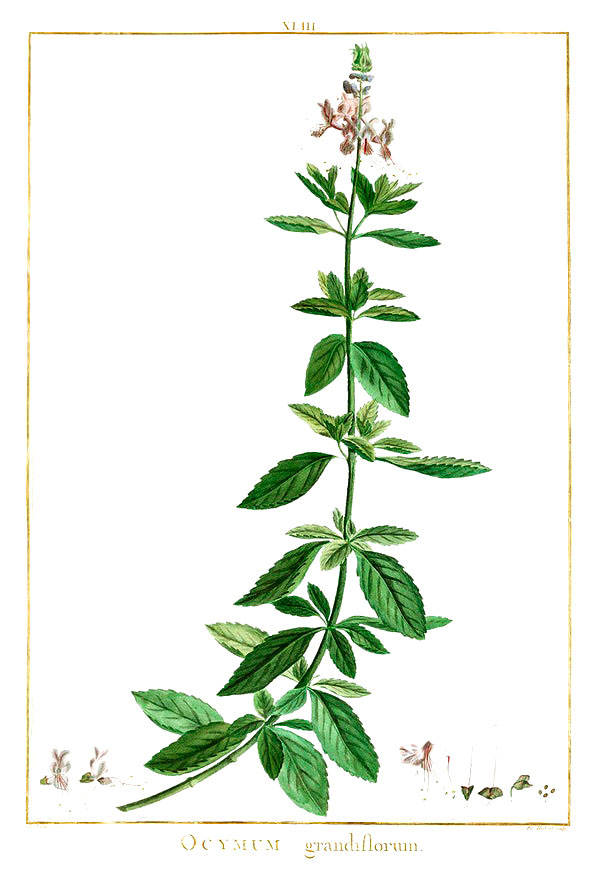Basil

Origin: South-East Asia
Family: Lamiaceae
Scientific Name: Ocimum basilicum L.
Folk Names: Alabahaca, American dittany, amorino (Tuscany), bacia-nicola (Italian: kiss-me-Nicholas), basilicon, common basil, our herb, royal basil, St. Joseph’s wort, sweet basil, witches’ herb
Magical
Element: Fire
Day: Tuesday
Planet: Mars
Zodiac: Scorpio
Deities: Aphrodite, Erzulie, Freda, Krishna, Lakshmi, Vishnu
Parts Used: Leaves, flowers
Magical Properties: Exorcism, love, money, purification, protection, wealth, chastity, fidelity, flying
Lore
- Ancient Egypt: Basil wreaths have been found in Egyptian tombs, and it was a common funerary herb in much of the mediterranean.
- Dioscorides listed basil in his Materia Medica as a treatment for scorpion stings, which remained a common belief until at least the early 18th century, and lead to the astrological association with scorpio.
- Nicholas Culpeper (1653) associates basil with Mars, and Scorpio, due to its association with scorpions.
- In Crete, basil is a symbol of mourning. There’s a folk song that translates to: “Basil, herb of mourning, blossom in front of my little window; I too will go to sleep full of sorrow, and will fall asleep crying.”
- Basil as a symbol of love and sexuality:
- Basil was a popular love herb in traditions of Italians, southern Slavs, Romanians, and several other Balkan peoples.
- In southern Italy, girls would wear basil on their chest or their girdle as a sign of purity and virginity, and married women would wear it around their head.
- In Tuscany, young peasant men would wear a sprig of basil behind their ears to visit their sweethearts.
- A man would place basil on the windowsill of a woman he hoped would fall in love with him.
- In a 15th century fairytale by Gentile Sermini, basil plays the tole of a mediator - when the young woman removed the pot of basil from her window, her lover was able to safely visit her room.
- Victorian flower language interprets basil to mean hate, loathing, and aversion.
Tulsi, or holy basil, (Ocimum tenuiflorum) is sacred in Hinduism, and associated with Vishnu.
Magical Uses
- Carry basil in your pocket to overcome obstacles to wealth.
- Burn an incense of basil with rose petals to help restore peace in a relationship.
- Attract customers to your business by placing basil in the cash register or at the door.
- Give basil as a house-warming gift to help ensure a home of love, luck, prosperity, and safety.
- Love divination: Place two fresh basil leaves on a lit coal: If they lie still and burn down, the relationship will be harmonious; a certain amount of crackling predicts a life of quarrels; the leaves flying apart indicates an undesirable match.
Aromatherapy
Part Used: Leaves, stems, and flowers
Extraction Method: Steam distillation
Flash Point: 80°C
Scent Type: Herbaceous
Perfume Note: Top/middle
Scent Description: Sweet/spicy herbaceous scent
Aromatherapeutic Uses
Basil oil is uplifting, and can help with anxiety and stress headaches.
Warnings:
- Not safe for use for folks with epilepsy/seizure disorders.
- Avoid during pregnancy or around children under 16.
Practical
Culinary
Basil leaves are often used in cooking, particularly fresh, and usually added at the last moment (as cooking fades the flavour), and is a primary ingredient in pesto sauce.
Basil flowers are also edible, and have a similar but more subtle flavour.
Botanical
Type: Annual herb
Plant size: 30-130cm
Leaves: Rich green and ovate, up to 6cm wide and 11cm long
Flowers: Small white flowers from an inflorescence off the central stem
Etymology: “Basil” comes from the Latin basilius for “royal/kingly plant”, possibly due to historical use in the production of royal perfumes.
In the Garden
Type: Annual
Sow: Early spring
Light: Bright light
Water: Keep moist
Soil: Rich and well-drained
Companion Planting: Lavender, tomatoes, cucumber, corn, apricot.
Tips:
- Prone to damp, water earlier in the day.
- To promote bushy growth, pinch the tip off the main stem.
- If leaves have wilted from lack of water, it should recover after being watered thoroughly and placed in a sunny location.
- Yellow lower leaves can be a sign of stress: it may need less water, or less/more fertiliser.
- Stems die off after producing flowers. You can continue leaf production by pinching off flowers as they form, or allow the flowers to mature to collect seeds to plant the following season.
